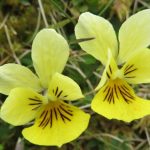The British Windflower Or Anemone
What a Spring it has been for wildflowers! I have never seen so many different species nor the sheer mass of pastel colours. In the Peak District the display started with anemone nemorosa, which we commonly call the windflower. It loves damp, light shade and is a woodland specialist. However, as so many trees have been lost over the past decades, it often still dominates treeless north facing slopes, those being less inclined to dry out. From February to May, the flower laid a white sheen over our wooded slopes and banks. Vast acreages were covered and readily seen because the leaves had yet to appear on the trees. The British windflower or anemone has been a joy.
Summer days
Now, in June, the windflower is no more. Even the leaves have died back, flopped in the deepening shade thrown by the mass of tree cover. No matter, other wildflowers are replacing them, the deep shadow specialists. This year I love the wildflowers even more because, in our rented barn, we have no garden. However, I have missed the tulips of my Dorset garden. Bulb catalogue fever is no longer one of my ailments. In amongst those tulips, a mass of blue anemones used to spring up from nowhere. These were anemone blanda, a rather flashy kind of windflower. They, though, as with the wild anemone, need well drained soil if they are to flourish.
Horses for courses
That light Dorset soil was anathema to my Japanese anemones. They hated the constant drying out in warm weather. They grew but rarely sufficient to flower well. This reminds us all of the need to place plants in suitable soil conditions. Nature does that, which is why mountain pansies flourish on well drained high spots. In the Peak District, we have both acid and calcareous soils, as well as dry and wet soils. It is essential to choose the right spot.
British windflower or anemone
Whether wild or garden flowers, anemones are a joy. If you want to know more then read this free guide here. If, like me, you have no garden then get out into the countryside and use nature as your therapy. We all need to look deeply into a flower and realise what joy lies within those petals.




